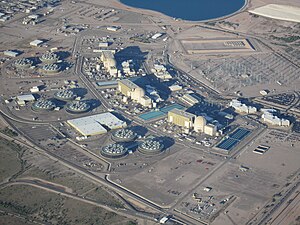| Palo Verde Generating Station | |
|---|---|
 The Palo Verde Generating Station, aerial view. | |
 | |
| Official name | Palo Verde Generating Station |
| Country | United States |
| Location | Tonopah, Arizona |
| Coordinates | 33°23′21″N 112°51′54″W / 33.38917°N 112.86500°W |
| Status | Operational |
| Construction began | Unit 1: 25 May 1976 Unit 2: 1 June 1976 Unit 3: 1 June 1976 |
| Commission date | Unit 1: 28 January 1986 Unit 2: 19 September 1986 Unit 3: 8 January 1988 |
| Construction cost | $5.9 billion (1986 USD)[1][2] ($13.9 billion in 2023 dollars[3]) |
| Owner(s) | Arizona Public Service (29.1%) Salt River Project (20.2%) El Paso Electric (15.8%) So. California Edison (15.8%) PNM Resources (7.5%) SCPPA (5.9%) LADWP (5.7%) |
| Operator(s) | Arizona Public Service |
| Nuclear power station | |
| Reactor type | PWR |
| Reactor supplier | Combustion Engineering |
| Cooling towers | 9 × Mechanical Draft[a] |
| Cooling source | Treated sewage |
| Thermal capacity | 3 × 3990 MWth |
| Power generation | |
| Units operational | 1 × 1400 MWe 1 × 1400 MWe 1 × 1400 MWe |
| Make and model | CE80 2-loop (DRYAMB) |
| Units cancelled | 2 × 1270 MWe |
| Nameplate capacity | 3937 MW |
| Capacity factor | 92.55% (2017) 82.80% (lifetime) |
| Annual net output | 31,920 GWh (2019) |
| External links | |
| Website | Palo Verde Generating Station |
| Commons | Related media on Commons |
The Palo Verde Generating Station is a nuclear power plant located near Tonopah, Arizona,[5] in western Arizona. It is located about 45 miles (72 km) west of downtown Phoenix. Palo Verde generates the most electricity of any power plant in the United States per year, the largest power plant by net generation as of 2021.[6] Palo Verde also has the third-largest rated capacity of any U.S power plant. It is a critical asset to the Southwest, generating approximately 32 million megawatt-hours annually.
Its average electric power production is about 3.3 gigawatts (GW),[5] and this power serves about four million people. Arizona Public Service (APS) operates and owns 29.1% of the plant. Its other major owners include the Salt River Project (20.2%), the El Paso Electric Company (15.8%), Southern California Edison (15.8%), PNM Resources (7.5%), the Southern California Public Power Authority (5.9%), and the Los Angeles Department of Water and Power (5.7%).[7] APS was granted a 20-year license extension to operate through 2045 for Unit 1, 2046 for Unit 2, and 2047 for Unit 3, with the option to submit a subsequent license renewal application for extended operation.
The Palo Verde Generating Station is located in the Arizona desert and is the only large nuclear power plant in the world that is not located near a large body of water. The power plant evaporates the water from the treated sewage from several nearby cities and towns to provide the cooling of the steam that it produces.
- ^ Cite error: The named reference
cost_auditwas invoked but never defined (see the help page). - ^ "EIA - State Nuclear Profiles". www.eia.gov. Archived from the original on 4 October 2017. Retrieved 3 October 2017.
- ^ Johnston, Louis; Williamson, Samuel H. (2023). "What Was the U.S. GDP Then?". MeasuringWorth. Retrieved November 30, 2023. United States Gross Domestic Product deflator figures follow the MeasuringWorth series.
- ^ "Palo Verde Nuclear Generating Station Tonopah, AZ". www.wje.com. Archived from the original on 7 May 2018. Retrieved 6 May 2018.
- ^ a b "Palo Verde Generating Station". U.S. Energy Information Administration. September 2010. Archived from the original on 2011-03-18. Retrieved 2011-04-26.
- ^ "Largest Utility Plants by Net Generation". Energy Information Administration. 24 October 2022. Archived from the original on 21 March 2023. Retrieved 11 October 2023.
- ^ PNM Resources Archived 2008-03-22 at the Wayback Machine formerly Public Service of New Mexico.
Cite error: There are <ref group=lower-alpha> tags or {{efn}} templates on this page, but the references will not show without a {{reflist|group=lower-alpha}} template or {{notelist}} template (see the help page).